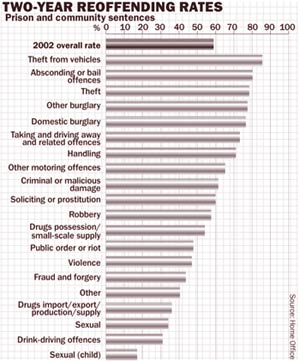One of our staff members is contributing considerably to a News Archiving service at Mu. Any well educated (Masters, PhD or above) users who wish to make comments on news sites, please contact Jim Burton directly rather than using this list, and we can work on maximising view count.
Research: Recidivism and other offending figures: Difference between revisions
mNo edit summary |
No edit summary |
||
| Line 1: | Line 1: | ||
{{research}} | |||
[[Image:Rr.jpg|frame|Source: Home Office ([[UK]])]]Recidivism and reoffending is low among sex offenders, particularly child sex offenders. Studies reporting 90 or 95% rates use flawed or atypical methodology that is not comparable to that used for other rates. | [[Image:Rr.jpg|frame|Source: Home Office ([[UK]])]]Recidivism and reoffending is low among sex offenders, particularly child sex offenders. Studies reporting 90 or 95% rates use flawed or atypical methodology that is not comparable to that used for other rates. | ||
Revision as of 19:16, 6 April 2009
 | ||||||||||||
| Part of NewgonWiki's research project | ||||||||||||
|---|---|---|---|---|---|---|---|---|---|---|---|---|
|
| ||||||||||||
| ||||||||||||
|
| ||||||||||||
| Template: Research - This template |

Recidivism and reoffending is low among sex offenders, particularly child sex offenders. Studies reporting 90 or 95% rates use flawed or atypical methodology that is not comparable to that used for other rates.
Estimates
13.4% in a 4.5 (average) year interval.
- Dr Frans Gieles on Hanson and Bussière (1998)
- "On average, the sex offense recidivism rate was 13.4% (n = 23.393). The average rate for rapists was 18.9% (n = 1.839), for child molesters it was 12.7% (n = 9.603). For nonsexual violence, the average recidivism rate was 12.2% (n = 7.155); for child molesters it was 9.9% (n = 1.774), but for rapists it was 22.1% (n = 782). When recidivism was defined as any reoffence, the rates were higher: 36.3% overall (n = 19.374), for child molesters 36,9% (n = 3.363) and for rapists 46.2% (n = 4017)".
- See also: Vnews.com.
14.3% in a 2 year interval.
- A. Shepherd and E. Whiting (2006) for the British Home Office.
3.3% rearrested within a 3 year interval.
- Recidivism of Sex Offenders Released from Prison in 1994, By Patrick A. Langan, Ph.D. (US DOJ)
- "Within the first 3 years following release from prison in 1994, 3.3% (141 of 4,295) of released child molesters were rearrested for another sex crime against a child".
10% recidivism rate for rapists (Grumfeld and Noreik (1986))
4% recidivism rate for incest offenders.
19% recidivism rate over 5 years for child molesters (Prentky, 1997)
10-29% and 13-40% recidivism rates for child molesters (Marshall and Barbaree (1990), compared to 7-35% for rapists for example.
- Recidivism of Sex Offenders - CSOM.org, 2001.
9.2% over a 15-year period for child molesters.
- Patrick, Steven, and Marsh, Robert (2009). "Recidivism Among Child Sexual Abusers: Initial Results of a 13-Year Longitudinal Random Sample," Journal of Child Sexual Abuse, 18(2), 123-136.
- "Forty-one of the 447 cases showed known recidivism for another sex crime (sex crime is a broader category than child sexual abuse). This means that the reconviction rate for sexual abuse was no more than 9.2% over this 15-year period."
- Why "Megan's" Laws Are Unconstitutional - Jim Love, Prisonerlife.com.
- "By writing the National Criminal Justice Reference Center, P.O. Box 6000, Rockville, Maryland 20849-6000, you can obtain the following reports.
- NCJ-163392 (February 7, 1997), Sex Offenses and Offenders: An Analysis of Data on Rape and Sexual Assault, finds the recidivism rate of 2,214 convicted rapists released from prison was 7.7% after three years. The only category of crimes with a lower recidivism rate are those persons convicted of murder (6.8%).
- NCJ-193427 (June, 2002), Recidivism of Prisoners Released in 1994, finds the recidivism rate of 3,138 convicted rapists released from prison was 2.5% after three years. The only category of crimes with a lower recidivism rate are those persons convicted of murder (1.2%).
- In April, 2001, the Ohio Department of Rehabilitation and Correction (ODRC) released a report also on the recidivism rate of released sex offenders. In Ten-Year Recidivism Follow-Up of 1989 Sex Offender Releases, Office of Policy, Bureau of Planning and Evaluation, Paul Konicek, Principle Researcher, (available at www.drc.state.oh.us), the recidivism rate of 879 sex offenders released from Ohio’s prisons in 1989, after ten (10) years, was found to be 8% for new sex offenses.
- The ODRC study finds its results as typical, citing to:
- 1) Gibbons, Soothill, and Way, found in Furby, Weinrott & Blackshaw, 1989. (Twelve year study finding sex offender recidivism rate of 4%).
- 2) Gibbons, Soothill, and Way 1980, found in Furby, Weinrott & Blackshaw, 1989. (Thirteen year study finding sex offenders recidivism rate of 12%).
- [...]
- 4) New York Department of Corrections, nine year follow-up study. Finding a 6% rate of recidivism for new sex offenses."